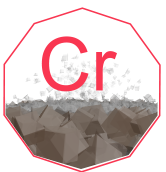Chromium

Chromium: Element Overview
Basic Information
- Symbol: Cr
- Atomic Number: 24
- Atomic Weight: 51.9961 u
- Element Category: Transition metal
- Group: 6
- Period: 4
Physical Properties
- Phase at Room Temperature: Solid
- Melting Point: 1907 °C (3465 °F)
- Boiling Point: 2671 °C (4840 °F)
- Density: 7.19 g/cm³ at 20 °C
- Color: Silvery-gray
- Crystal Structure: Body-centered cubic (bcc)
Chemical Properties
- Electronegativity: 1.66 (Pauling scale)
- Ionization Energies:
- First: 652.9 kJ/mol
- Second: 1590.6 kJ/mol
- Third: 2987 kJ/mol
- Oxidation States: +6, +3, +2 (most common are +6 and +3)
- Reactivity: Forms stable compounds with most nonmetals and reacts with acids to form chromium salts. Chromium in its +3 oxidation state is most stable.
Isotopes
- Stable Isotopes: Chromium has four stable isotopes: Cr-50, Cr-52, Cr-53, and Cr-54.
- Cr-52: 83.789%
- Cr-53: 9.501%
- Cr-50: 4.345%
- Cr-54: 2.365%
- Radioisotopes: Several radioisotopes are known, including Cr-51, which is used in medical and biological research.
Occurrence and Production
- Natural Abundance: Chromium is the 21st most abundant element in the Earth’s crust.
- Sources: Found in minerals such as chromite (FeCr₂O₄).
- Production: Primarily produced by the reduction of chromite ore with carbon or aluminum in an electric arc furnace.
Uses and Applications
- Stainless Steel: A key component in stainless steel, providing corrosion resistance and hardness.
- Plating: Used in chrome plating to produce a shiny, protective, and decorative coating on metal objects.
- Pigments: Used to produce various pigments, including chrome yellow (lead chromate), which is used in paints and dyes.
- Refractories: Used in the manufacture of refractory materials that withstand high temperatures.
- Catalysts: Used as a catalyst in various chemical reactions, including the production of synthetic rubbers and plastics.
- Tanning: Chromium salts are used in leather tanning to produce high-quality leather goods.
Safety and Precautions
- Reactivity: Chromium metal is relatively non-reactive, but chromium compounds, particularly hexavalent chromium (Cr(VI)), are highly toxic and carcinogenic.
- Handling: Chromium and its compounds should be handled with care, using appropriate protective equipment.
- Health: Prolonged exposure to hexavalent chromium compounds can cause respiratory problems, skin irritation, and cancer. Trivalent chromium (Cr(III)) is an essential nutrient in trace amounts.
Biological Role
- Essential Element: Trivalent chromium (Cr(III)) is essential for humans in trace amounts and plays a role in glucose metabolism.
- Toxicity: Hexavalent chromium (Cr(VI)) is highly toxic and a known carcinogen.
Historical Background
- Discovery: Discovered in 1797 by Louis Nicolas Vauquelin.
- Naming: Named from the Greek word “chroma,” meaning color, due to the many colorful compounds it forms.
Interesting Facts
- Chromium Compounds: Known for their bright and varied colors, such as chrome green (Cr₂O₃) and chrome red (PbCrO₄).
- Corrosion Resistance: Stainless steel, which contains chromium, is widely used for its resistance to rust and corrosion.
- Ruby and Emerald: The red color of rubies and the green color of emeralds are due to traces of chromium.
Summary
Chromium is a versatile transition metal known for its use in stainless steel, plating, pigments, and various industrial applications. Discovered in the late 18th century, chromium is valued for its corrosion resistance and the colorful compounds it forms. While essential in trace amounts, chromium can be toxic in higher concentrations, particularly in its hexavalent form. Its unique properties make it a crucial material in modern technology and manufacturing.
Questions and Answers about Chromium:
Q: What is the chemical symbol for Chromium?
- A: Cr
Q: What is the atomic number of Chromium?
- A: 24
Q: What type of element is Chromium?
- A: Transition metal
Q: What is the atomic weight of Chromium?
- A: 51.9961 u
Q: What group is Chromium in?
- A: Group 6
Q: What period is Chromium in?
- A: Period 4
Q: What is the phase of Chromium at room temperature?
- A: Solid
Q: What is the melting point of Chromium?
- A: 1907 °C (3465 °F)
Q: What is the boiling point of Chromium?
- A: 2671 °C (4840 °F)
Q: What is the density of Chromium at 20 °C?
- A: 7.19 g/cm³
Q: What is the color of Chromium metal?
- A: Silvery-gray
Q: What is the crystal structure of Chromium?
- A: Body-centered cubic (bcc)
Q: What is the electronegativity of Chromium?
- A: 1.66 (Pauling scale)
Q: What is the first ionization energy of Chromium?
- A: 652.9 kJ/mol
Q: How many stable isotopes does Chromium have?
- A: Four (Cr-50, Cr-52, Cr-53, Cr-54)
Q: What is the most abundant isotope of Chromium?
- A: Cr-52
Q: How is Chromium commercially produced?
- A: By reduction of chromite ore with carbon or aluminum in an electric arc furnace
Q: What is the natural abundance of Chromium in the Earth’s crust?
- A: 21st most abundant element
Q: What common mineral contains Chromium?
- A: Chromite (FeCr₂O₄)
Q: What industry uses Chromium extensively for stainless steel production?
- A: Steel and construction industry
Q: What is one use of Chromium in the plating industry?
- A: Used for chrome plating to provide a shiny, protective coating
Q: What role does Chromium play in the production of pigments?
- A: Used to produce various pigments, including chrome yellow and chrome green
Q: Why is Chromium used in refractory materials?
- A: Due to its ability to withstand high temperatures
Q: What is the biological role of Chromium in the body?
- A: Trivalent chromium (Cr(III)) is essential for glucose metabolism
Q: Who discovered Chromium?
- A: Louis Nicolas Vauquelin
Q: In what year was Chromium discovered?
- A: 1797
Q: What is the origin of the name “Chromium”?
- A: From the Greek word “chroma,” meaning color
Q: What property makes Chromium suitable for use in stainless steel?
- A: Its corrosion resistance
Q: What health hazard is associated with hexavalent Chromium?
- A: It is highly toxic and a known carcinogen
Q: How should Chromium compounds be handled?
- A: With care, using appropriate protective equipment to avoid exposure
Q: What is the second ionization energy of Chromium?
- A: 1590.6 kJ/mol
Q: What is the third ionization energy of Chromium?
- A: 2987 kJ/mol
Q: Is Chromium essential for plant health?
- A: Not essential for plants
Q: What is the significance of Chromium in the production of synthetic rubbers?
- A: Used as a catalyst in the chemical reactions
Q: What is the role of Chromium in high-performance materials?
- A: Provides strength, hardness, and corrosion resistance
Q: How does Chromium benefit the aerospace industry?
- A: Used in high-performance materials for aircraft components
Q: What is Chromium’s role in improving leather quality?
- A: Used in leather tanning to produce high-quality leather
Q: What is the use of Chromium in medical research?
- A: Radioisotope Cr-51 is used in biological and medical research
Q: How does Chromium contribute to the production of synthetic rubbers and plastics?
- A: Used as a catalyst in the synthesis process
Q: What color are Chromium compounds typically?
- A: They can exhibit a variety of bright and vivid colors






